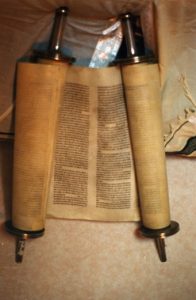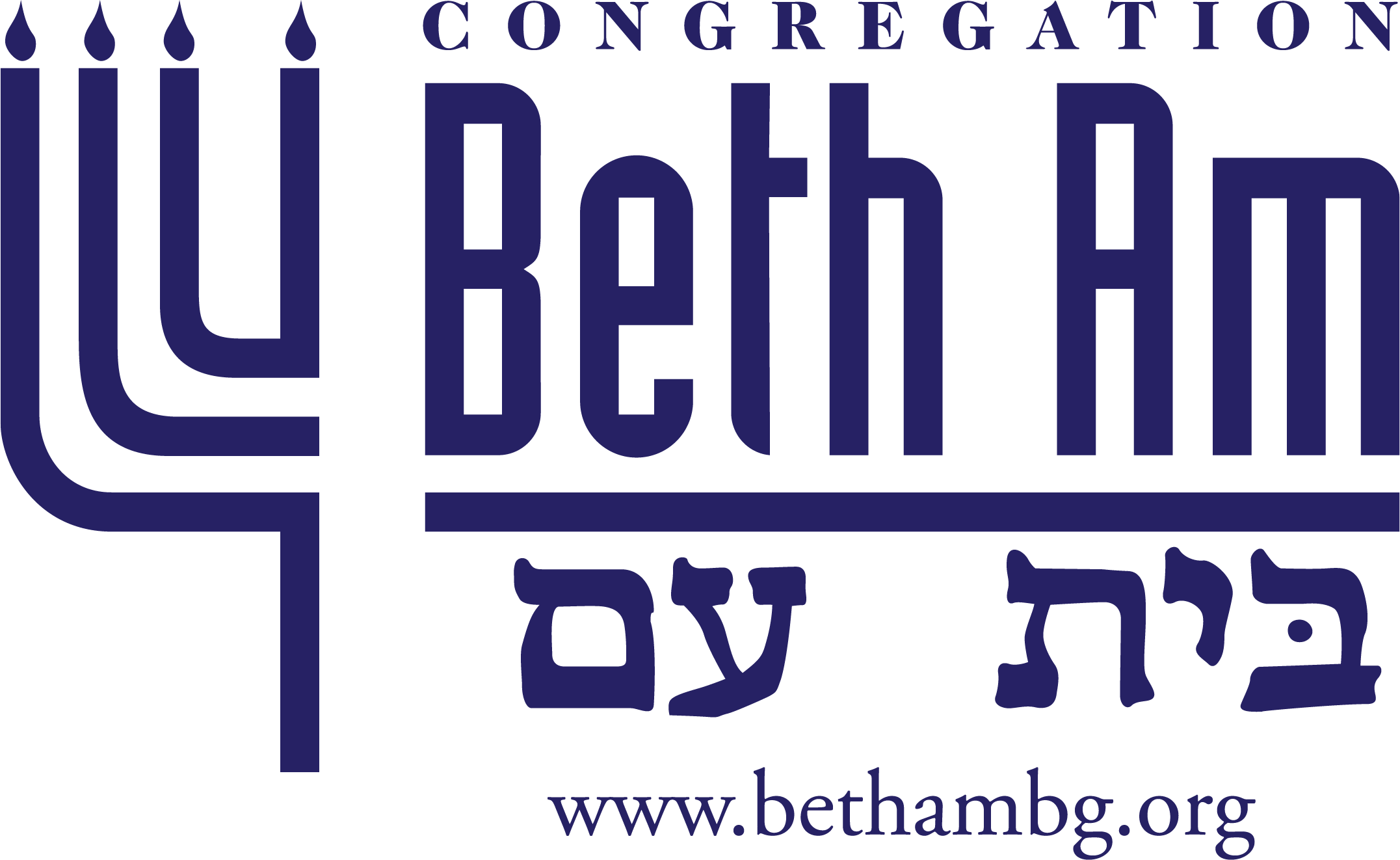The Beth Am Czech Torah Story

In 1987, the membership of Congregation Beth Am, then in Wheeling Illinois, learned that scrolls were available to congregations in need of them, through the Czech Memorial Scrolls Trust in London. The congregation’s founder had visited London and had seen the scrolls at the Trust. Later, the congregation’s president began negotiations to acquire one of the scrolls. Each donation of $10 purchased a tiny envelope with a silver footprint on it. The envelope could be printed with the name of someone being honored or memorialized and it was placed on the map. The footprints stretched from Czechoslovakia to London and across the ocean to Chicago. The goal was to collect $700 to pay for the donation required for a scroll.
Some investigation went into the history of the scrolls. A fund was established under the Title “Footsteps to Freedom”. A wall was converted into a map of Europe, the Atlantic Ocean and the United States. Czechoslovakia, England and Chicago were highlighted on the map.
Constant publicity within the congregation, cantor’s articles, etc. was utilized to gain the attention of the members. Everyone was extremely excited about the project. In the end, a total of over $5,000 was donated; some to be used for the donation to the Trust, some to be used to dress the scroll and some went to an ongoing project for a new ark. Cantor Arnold E. Schultz and his wife Susan went to England as part of a visit to friends who live there and the scroll from Kojetine was picked up.
This scroll, written in 1840, was transported back to Chicago with the help of British Airways who donated a seat for the scroll so that it would not travel as freight. When the scroll was picked up in London, Mrs. Shafer, the trustee, was handed a check for $2,000.
On a Shabbat a few weeks after the scroll came to Beth Am, the entire congregation along with visiting Survivors filled the sanctuary to overflowing. When the time came for the Torah service, the undressed scroll was brought down the center aisle by the Cantor and then passed hand to hand past presidents to the current president and then to the Rabbi who placed the mantle onto the scroll. Not a dry eye could be found in the entire sanctuary. Everyone wept for the souls who were lost from that town. Later, a speaker from the local Holocaust foundation spoke of her time as a teenager in Prague before and after the Nazi onslaught. As time went on, more and more information was gathered about the town, its inhabitants and the fate of those Jews. With help from contacts both in London and in Washington D.C., a picture was formed of the town’s history and those souls who lived there during the war. A great deal of research went into this particular scroll and its former owners. The congregation made a concerted effort to not forget that this scroll was special. Children vie for the honor of reading from this scroll on their B’nei Mitzvah. Since the scroll is difficult to read, students must try extra hard to gain enough skill to do it honor. At every service, when mourner’s kaddish is read, the “Jews of Kojetine” are added to the list of those names read out for Yahrtzeits and S’loshim. The students in the school are exposed to the history of that scroll as part of the curriculum. The Cantor relates the history of the Czech scrolls and the history of the Jews of Kojetine. The list of names and ages of the people from that town along with their occupations are handed out and the children see the names of children their own age that perished. The impression those 58 names make is so much greater than a nameless 6 million. Students who wish to “twin” their B’nei Mitzvah with one of those children from Kojetine, in addition to the proper Hebrew skills, are required to write a biography of that person as if they lived, thus giving life to an innocent that perished.When the congregation moved to a much larger building in Buffalo Grove, a village contiguous to Wheeling, a Yahrtzeit alcove was built to house the Yahrtzeit lights.
In that alcove is a section on the Jews of Kojetine including the certificate from the Scrolls Trust, a photograph of the interior of the Kojetine sanctuary circa 1930, a plaque commemorating the deportation of the Jews and a listing the names of those who perished.
Each June, on a Friday night closest to the date of the deportation, the congregation remembers the people of Kojetine. Fifty-eight Yahrtzeit candles are placed in the front of the sanctuary and the first fifty-eight people who arrive are each given a card with the name and age of someone from that town that perished. Those people light a candle prior to the beginning of Shabbat services. During the service, the scroll is removed from the ark and read and the story of the Jews of Kojetine is related including any recent information that had come to light during the previous year. At the time of the mourners kaddish, with the reading of Yahrtzeit names and those who died in the past month, each person with a card stands and reads aloud the name and age written there.
Cantor Schultz has lectured to the members of the Cantors Assembly, the worldwide organization of Conservative cantors, on the Czech scrolls and how to research and use them.
In early 2001, friends in London discovered a scroll at a closing home for Jewish elderly that was marked for burial. A request was made of the Scrolls Trust for Beth Am to acquire that scroll as well and, with the proper donation, that acquisition was approved. Once that scroll was brought to the congregation, a member who is a professor of history at a local college, embarked over a summer to research the history of that town, Roudnice. With help from Yad Vashem and the curator of the museum in Roudnice, a picture of the history of the Jews of Roudnice and their experiences during the Holocaust was developed including a detailed history of the deportation and the fate of those people. Both of the Czech scrolls and the people from the towns from which they came, are constantly remembered by the members at Beth Am. The people of Beth Am have adopted the scrolls from the towns with great history but no congregants. This insures that those souls and their history will not be forgotten and the congregation that now keeps the scrolls in trust will be enriched with that history. Cantor Schultz is now semi-retired and holds the position of “Emeritus” at Beth Am, but he is still very much involved in the Czech scrolls and continues to lecture the children each year on their history. Cantor Schultz also continues to lecture on the Czech scrolls to organizations in the United States. *** This was taken from “www.JudaicResources.com“.
Roudnice Nad Labem
The history of Jewish people living in Roudnice is a story of oppression and destruction. Unfortunately, this is not an uncommon theme throughout Jewish history. Jewish life in Rounice was first established in 1541. However, by 1592 only fourteen total Jewish families were living in Roudnice. Although Jews were given some liberties, such as being granted a charter, it did not take long after for the development and implementation of Jewish ghettos to take hold in Roudnice.
By 1615 Jewish people began to be displaced, and religious buildings were taken away, the only Jewish synagogue and cemetery torn down and replaced by the monastery. Jewish people were then kicked out of their homes and forced into a different ghetto. Today it is Havlickova Street west of the Chateau and the bridge over the Elbe River. After being transplanted into their new homes, the 30 years of war brought great suffering to the Jewish community.
Most of the 30-Year War devastation took place in Bohemia and Moravia. Jews were burdened with tax burdens, needing money to sustain themselves throughout the war. However, the Jewish community was able to create a new Jewish cemetery to bury all their loved ones lost before and during the war. Tombs were transferred over from the original cemetery to their previous Ghetto.
Then in 1631, mass devastation took hold of their daily lives when Saxons burned down their Ghetto. During that time, there were 90 Jewish people left within that Ghetto. Twenty years later, in 1651, the population grew to 218 Jewish people living in tight conditions with 23 houses split amongst themselves. The rebuilding of the Ghetto and synagogue took place. By 1675, a synagogue was rebuilt with 350 seats.
In 1713 a plague ravaged the community, killing one-third of the Jewish population. By 1724 the Jewish community had 448 people, and the East portion of the Ghetto was abolished. Unfortunately, a massacre took place in 1744, killing many in the Jewish community. The remaining community built a synagogue. However, it was ultimately torn down in the mid-1800s due to the construction of a railroad. By then, the Jewish population had declined as people moved to larger cities. Nevertheless, 176 Jewish families remained in Roudnice.
In 1853 the community rebuilt the synagogue on the North side of Havlickova Street, which was partly built on the site of the second synagogue. They then built a new Cemetery located 1 km west of the second cemetery and 1800 meters west of the bridge on Hrbitovni Street. This cemetery was completed by 1896.
From 1902 to 1930, the Jewish population declined rapidly. The community went from 448 Jewish persons to 166 Jewish persons, 1.7% of the total population of Roudnice within this period. Then the Second World War broke out, leading to catastrophic devastation for the Jewish community of Roudnice. The Holocaust led to most Jews being deported Kladno (February 6-12, 1942). Other groups of Jews from Roudnice were transported to Terezin or Prague.
During this time of displacement, Jews were identified by the lists compiled by the Roudnice community. Roudnice Jews, after Tezein, were deported elsewhere: Izbicka, Gleiwitz, Trawniki, Zamosc, Blechhamer, Kavencin, and Raasika. Approximately 76 perished during this time period. The Nazis destroyed the new cemetery built in 1896. However, luckily there was minimal damage to the synagogue.
After the Holocaust, the Jewish community in Roudnice consists of only a few Jews. The synagogue was used as a boarding house and school in 1953. Currently, the synagogue is closed and in need of repairs. However, there is hope, since the end of communism in 1989, to restore the synagogue and make it a Jewish Museum.
Both cemeteries are in the process of being restored. Both are proclaimed historical landmarks. City Hall manages the new cemetery—many cases of vandalism to the new cemetery during the Communist regime. One long original Jewish street and its building remain intact. Unfortunately, a large majority of the Jewish street was destroyed in 1973.
